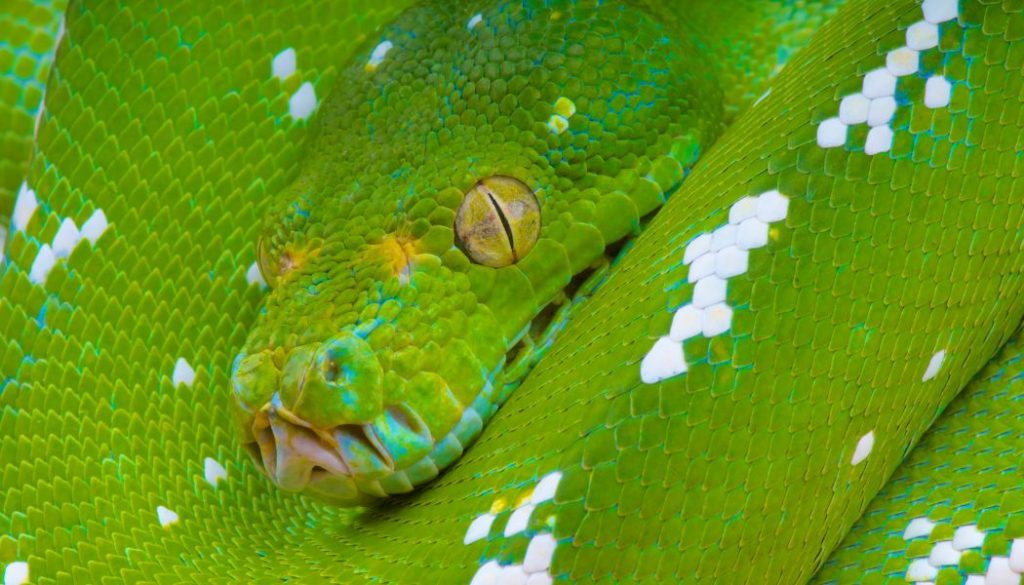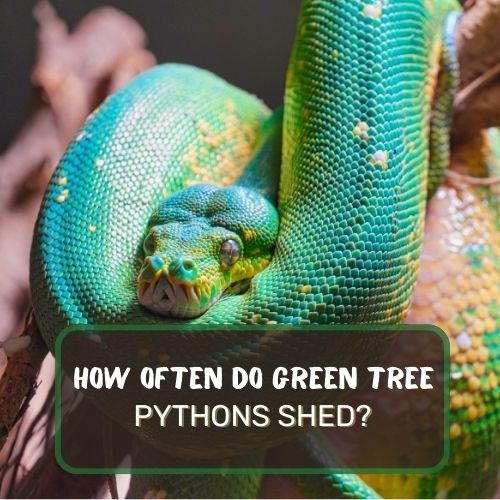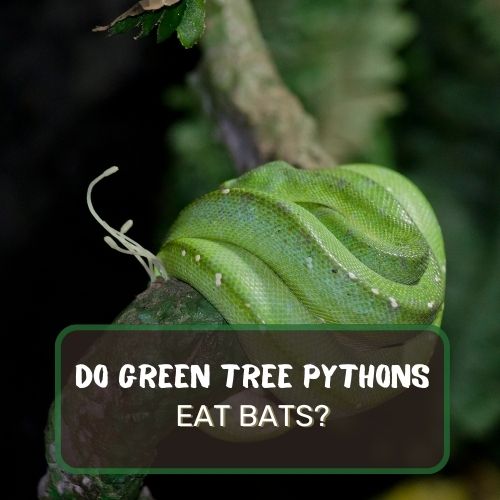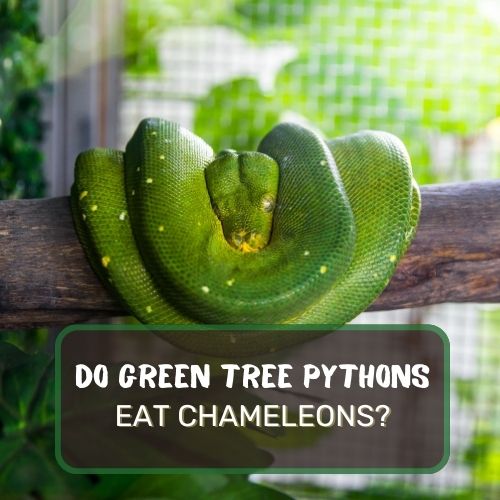Welcome to your ultimate guide on green tree python temperature and humidity! Keeping these slithering beauties comfortable and healthy is all about getting their living conditions just right.
Green tree pythons thrive when their temperature and humidity are on point. For temperature, aim for a daytime range of 82°F to 88°F and a nighttime dip to about 75°F to 80°F. As for humidity, you’ll want to maintain a level between 50-70%.
Monitoring both temperature and humidity is essential for your python’s well-being, affecting everything from their metabolism to their ability to shed skin properly. Use reliable thermometers, hygrometers, and thermostats to keep conditions stable.
It’s all about mimicking their natural habitat for a happy, healthy snake!
In this article, we’ll explore their natural habitat to understand what makes them tick. Then we’ll delve into the critical factors of temperature and humidity, offering expert tips to help you become the best python caretaker around.
We’ll cover ideal ranges, how to maintain them, and even answer some frequently asked questions. Trust me, it’s going to be an eye-opener!

Table of Contents
The Natural Habitat of Green Tree Pythons
First things first, let’s talk about where these magnificent creatures come from—the lush rainforests of Australia, Indonesia, and Papua New Guinea. Imagine tall trees, leafy canopies, and a climate that’s more like a spa day every day for these pythons.
The average temperature here ranges from 78°F to 88°F, and the humidity is often sky-high. Understanding their natural habitat helps us replicate those conditions in captivity.
After all, we’re trying to mimic Mother Nature, the ultimate green tree python caretaker!
Understanding The Importance of Temperature
Alright, so why does temperature matter so much? Think of temperature as the thermostat of your python’s life. Too hot or too cold, and you’re throwing their entire system out of whack.
Their metabolism, digestion, and overall health are all tied to temperature.
In the wild, green tree pythons adjust their body temperature through thermoregulation. They find sunny spots when they’re cold and shady areas when they’re too warm. In captivity, they can’t do that. That’s where you come in as their climate manager.
Here’s a quick example. Imagine you’re stuck in a room where it’s either too hot like a sauna or too cold like an icebox. Your energy levels would plummet, right? The same goes for your python.
Inaccurate temperatures can lead to stress, reduced appetite, and even respiratory issues.
Too cold? Your python may become lethargic and refuse to eat. Too hot? You risk overheating and dehydration, not to mention the increased likelihood of stress-related behaviors like pacing or hiding.
These are signs that you need to fine-tune the climate inside that enclosure. We’re not just talking degrees here; we’re talking about the well-being of a living, breathing creature.
By focusing on the right temperature ranges for both daytime and nighttime, you’re setting the stage for a healthy and happy green tree python.
Monitoring and adjustments are key, and later on, we’ll get into the nitty-gritty of how to do that effectively.
Ideal Temperature Ranges
So, you’re probably wondering, “Okay, what’s the magic number?” Good question! For an adult green tree python, aim for daytime temperatures between 82°F and 88°F. At night, you can let the temp drop to around 75°F to 80°F.
These snakes are nocturnal, so they can handle a bit of a cooler climate when the sun goes down. Juveniles are a bit more sensitive, needing temperatures on the warmer side, closer to 85°F during the day.
Sure, these are general ranges, but remember, every snake is an individual. Some might prefer the warmer end of the spectrum, while others might lean towards the cooler side. Pay attention to your python’s behavior to tailor the temperature just right for them.
How to Maintain the Right Temperature
Alright, you’ve got your ideal temperature range, but how do you maintain it? You’ve got options, my friend. Heating elements are your go-to for this. Heat lamps, ceramic heat emitters, and under-tank heating pads can all help you get the job done.
Now, don’t just put a heating element in there and call it a day. Positioning is crucial. Place a high-quality digital thermometer at both the warmer and cooler ends of the enclosure.
This way, you’re ensuring a temperature gradient—your python can choose where it wants to hang out.
Here’s a pro tip: Use a thermostat. It automatically turns the heat source on and off to maintain the ideal temperature. It’s like cruise control but for your snake’s home.
Seasonal changes? No biggie. If you’re getting into the colder months, you may need to tweak your heating setup. During warmer months, your room’s ambient temperature might be sufficient.
Just keep those thermometers and thermostats dialed in, and you’re golden.
Consistency is key. Regularly check those thermometers, make adjustments as needed, and keep an eye on your snake’s behavior.
Trust me, if you’re vigilant about temperature control, you’re well on your way to having a content, comfortable, and healthy green tree python.
Up next, let’s dig into why humidity is equally vital in your python’s life. Stick around; you won’t want to miss it!
Understanding The Importance of Humidity
Alright, let’s switch gears and talk humidity. If temperature is the thermostat of your green tree python’s life, think of humidity as the moisture level in their personal spa. Humidity plays a massive role in helping these reptiles shed their skin.
If the air’s too dry, they’ll have a tough time breaking free from their old scales. Trust me, no one wants to see a snake struggle with a bad shed; it’s like trying to peel off skinny jeans after a sweaty day.
Humidity doesn’t just affect shedding; it’s also key for respiratory health. Too low humidity levels can lead to respiratory infections, while too high levels can cause fungal growth in the enclosure. It’s a balancing act that you’ve got to master.
Consider this: you know how your skin feels dry and itchy in winter when the air is dry? It’s similar for your green tree python. If the air’s not humid enough, it can stress your snake out, leading to various health issues over time. But don’t go overboard!
Too much humidity and you’ve got a mold and mildew party that nobody wants to attend.
Ideal Humidity Levels
So what’s the Goldilocks zone for humidity? Aim for a humidity level of around 50-70%. Juvenile pythons may require slightly higher humidity, closer to 70%, especially during shedding.
Place a reliable hygrometer in the enclosure to keep track. It’s not a set-it-and-forget-it deal; you’ve got to monitor regularly.
Depending on your living conditions, achieving this range can be easy-peasy or a bit of a challenge. If you’re in a desert area, you’ll need to work harder to maintain proper humidity.
If you’re somewhere more humid, you might not need to make as many adjustments. The bottom line? Keep an eye on that hygrometer and adjust as needed.
Coming up next, we’ll dive into how to maintain these ideal humidity levels without breaking a sweat. Stay tuned!
How to Maintain the Right Humidity
Okay, let’s get into the how-to’s of maintaining that just-right humidity. First off, misting is your friend. A good misting bottle can help you increase humidity levels with just a few spritzes.
But hey, we’re in the 21st century; why not automate? A reptile fogger or humidifier can take the manual labor out of the equation.
Natural plants can also be a great addition. Not only do they look pretty, but they also naturally release water vapor into the air. It’s like a two-for-one deal—decoration and humidity control.
Don’t overlook the substrate, either. Cypress mulch and coconut husk are excellent at retaining moisture. A damp—not wet—substrate can go a long way in maintaining humidity.
And here’s where it gets technical. For an accurate reading, place a hygrometer near the middle of the enclosure. This gives you a more realistic average humidity level.
Now, if you find that you’re consistently falling outside of the ideal 50-70% range, it’s time to make some adjustments. Either mist more frequently, adjust your humidifier, or even cover part of the top of the enclosure to trap in moisture.
Conclusion
You’ve journeyed through the ins and outs of green tree python temperature and humidity, understanding why these factors are crucial for your snake’s well-being.
From the ideal temperature ranges of 82°F to 88°F during the day and 75°F to 80°F at night, to maintaining a humidity level of 50-70%, you’re now equipped with the knowledge to create a perfect environment for your green tree python.
Monitoring and adjustments are your best tools, so keep that in mind moving forward.
You’re well on your way to becoming an exemplary snake parent. Keep up the great work!
FAQ
What temperature should a green tree python be at?
Adult green tree pythons thrive at daytime temperatures between 82°F and 88°F, and nighttime temps of 75°F to 80°F.
How much humidity does a green tree python need?
Aim for a humidity level between 50-70%. Juveniles may need the higher end of that range, especially during shedding.
Do green tree pythons need a heat lamp?
Yes, a heat lamp is a popular way to maintain temperature, but ceramic heat emitters and under-tank heating pads also work well. Remember, always use a thermostat for regulation.
How often do you mist a green tree python?
It depends on the current humidity levels. Check your hygrometer regularly and mist as needed to maintain that 50-70% sweet spot.
There you have it! You’re well on your way to becoming a green tree python climate guru. Keep an eye on those levels, make adjustments as needed, and your snake will be living the good life in no time!




0 Comments